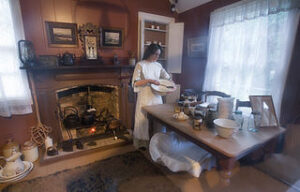
On August 23, 1902 Fanny Farmer opened her School of Cookery and continued her revolution in American cookery. In order to appreciate her efforts, it’s useful to start with a recipe comparison for Bird’s Nest Pudding.
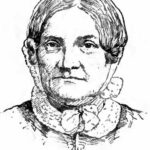
The original 1833 recipe is from The American Frugal Housewife by Lydia Maria Child.
Bird’s Nest Pudding
If you wish to make what is called ‘Bird’s-nest puddings,’ prepare your custard, take eight or ten pleasant apples, pare them and dig out the core, but leave them whole, set them in a pudding dish, pour your custard over them, and bake them about twenty or thirty minutes.
The baking occurred in a Dutch oven set to the side of the fire with hot coals on top of the lid.
Questions arise. What is a ‘pleasant’ apple? What temperature should the oven be? Where’s the custard recipe?
Compare Lydia’s recipe with modern directions
Modern recipe from the Old Sturbridge Village website.
6-8+ apples
2 cups of milk
3 eggs
½ cup of brown sugar
½ teaspoon of cinnamon
Preheat the oven to 350⁰F
Grease a deep casserole dish (round or rectangular- 9 by 9 inches square or a 9 inch deep pie plate, or a 9 inch Bundt pan)
Peel and core apples and leave whole, to fit snugly in the baking dish.
Make the custard by beating the milk, eggs, brown sugar, and cinnamon together well.
Pour the custard over the apples in the dish.
Bake for 30-40 minutes until the custard is set.
Eat hot or cold.
If you find the modern recipe easier to understand, thank Fanny Farmer.
Fanny Farmer & the Modern Recipe
Fanny Farmer invented the modern recipe such as the one above. She was the first professional cook to insist on precise measurements — level teaspons, level cups, level ounces. No more ‘a handful of this’ and ‘a goodly amount of that.’
Fanny didn’t expect a career in cookery. She wanted to attend a women’s college and become a teacher, but at the age of sixteen she suffered what may have been a paralytic stroke and was told she shouldn’t leave the house, or apply herself intellectually.
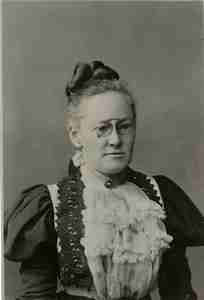
Fanny didn’t give up, and took a position as a governess for the Shaw family. Her employer saw Fanny’s interest in cooking and encouraged her to enroll in the Boston Cooking School that had been founded to enable women of modest means to obtain employment as cooks. When Fanny graduated in 1889, she joined the school staff. Two years later she became the principal. And in 1896 Fanny published her first cook book, one that didn’t assume women naturally knew how to cook.
“Good judgment, with experience, has taught some to measure by sight,” she wrote, “but the majority need definite guides.”
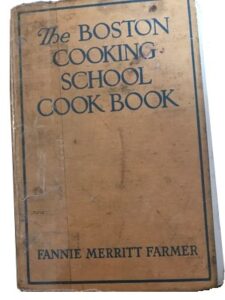
The 1896 cook book had 1800 recipes. The publisher wasn’t confident the book would sell, because he thought women already knew how to cook. Fanny raised money to pay for the first 3,000 copies, and kept the copyright. The cookbook sold millions of copies.
Fanny’s book and her methods became popular. She became a leading figure on the lecture circuit with her weekly lectures published in the Boston Evening Transcript, and was one of the first women to lecture at Harvard Medical School. She believed that “the time is not far distant when a knolwedge of the principles of diet will be an essential part of one’s education. Then mankind will eat to live, will be able to do better mental and physical work, and disease will be less frequent.“
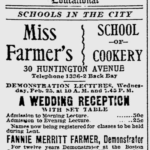
In 1902 Fanny established Miss Farmer’s School of Cookery in Boston and made enough money to build a house and support her parents and other family members.
Fanny Farmer’s Brownies
Fanny’s 1896 recipe for brownies didn’t contain any chocolate, because it wasn’t readily available.
Original 1896 recipe:
1/3 cup butter
1/3 cup powdered sugar
1/3rd cup Porto Rico [sic] molasses
1 egg well beaten
7/8 cup bread flower
1 cup pecan meat cut in pieces
Mix ingredients in order given. Bake in small, shallow fancy cake tins, garnishing top of each cake with 1/2 pecan.
Modern Translation:
1/3 cup (75 mL) butter at room temperature
1/3 cup (75 mL) powdered icing sugar
1/3 cup (75 mL) cooking or fancy molasses
1 egg
7/8 cup (240 mL) bread flour
1 cup (250 mL) chopped pecans
Pre heat oven to 350ºF (180ºC)
Mix ingredients in order, then bake 15-20 minutes in small, shallow tart tins.
Makes about 4.
Let cool on rack before serving.
You can easily substitute darker molasses or Maple syrup for the fancy molasses if you wish.
In 1902, Fanny opened her cooking school on August 23. This Friday, whether you cook or not, take a moment to think of Fannie Farmer and the modern recipes we use today.
Woman in replica of 19th century kitchen by Jorge Royan
Lydia Marie Child
Fanny Farmer
Advertisement for Miss Farmer’s School of Cookery, 1903
Kat Eschner. “Fanny Farmer was the Original Rachel Ray.” Smithsonian. Aug. 23, 2017.
Julie Moskin. “Overlooked No More: Fannie Farmer, Modern Cookery’s Pioneer.” New York Times. June 13, 2018.

Sandra Wagner-Wright holds the doctoral degree in history and taught women’s and global history at the University of Hawai`i. Sandra travels for her research, most recently to Salem, Massachusetts, the setting of her new Salem Stories series. She also enjoys traveling for new experiences. Recent trips include Antarctica and a river cruise on the Rhine from Amsterdam to Basel.
Sandra particularly likes writing about strong women who make a difference. She lives in Hilo, Hawai`i with her family and writes a blog relating to history, travel, and the idiosyncrasies of life.



Always enjoy your blogs, this one particularly because of it’s history, women who needed cook books to be better at cooking! History of Fanny Farmer! Thank you!
I learned to cook from a Fanny Farmer cookbook. It’s nice to see her being remembered as the groundbreaker she was.
It’s amazing how many activities, like cooking, we take for granted. Thank you for your comment.